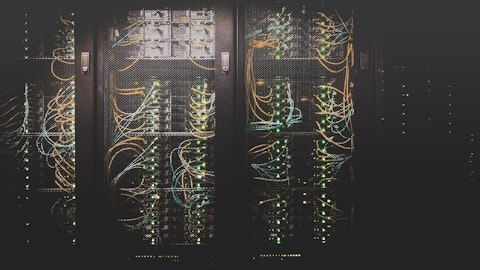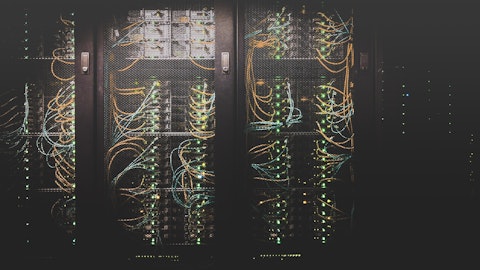Arista Networks, Inc. (NYSE:ANET) Q4 2022 Earnings Call Transcript February 13, 2023
Operator: Welcome to the Fourth Quarter 2022 Arista Networks Financial Results Earnings Conference Call. As a reminder, this conference is being recorded and will be available for replay from the Investor Relations section at the Arista website following this call. Ms. Liz Stine, Arista’s Director of Investor Relations, you may begin.
Liz Stine: Thank you, operator. Good afternoon, everyone and thank you for joining us. With me on today’s call are Jayshree Ullal, Arista Networks’ President and Chief Executive Officer and Ita Brennan, Arista’s Chief Financial Officer. This afternoon, Arista Networks issued a press release announcing the results for its fiscal fourth quarter ending December 31, 2022. If you would like a copy of this release, you can access it online at our website. During the course of this conference call, Arista Networks management will make forward-looking statements, including those relating to our financial outlook for the first quarter of the 2023 fiscal year, longer term financial outlook for 2023 and beyond, our total addressable market and strategy for addressing these market opportunities, supply chain constraints, component costs, manufacturing capacity, inventory purchases and inflationary pressures on our business, extended lead times, product innovation, and the benefits of acquisitions, which are subject to the risks and uncertainties that we discuss in detail in our documents filed with the SEC, specifically in our most recent Form 10-Q and Form 10-K and which could cause actual results to differ materially from those anticipated by these statements.
These forward-looking statements apply as of today and you should not rely on them as representing our views in the future. We undertake no obligation to update these statements after this call. Also, please note that certain financial measures we use on this call are expressed on a non-GAAP basis and have been adjusted to exclude certain charges. We have provided reconciliations of these non-GAAP financial measures to GAAP financial measures in our earnings press release. With that, I will turn the call over to Jayshree.
Jayshree Ullal: Thank you, Liz. And I am glad we avoided Valentine’s Day this time. Thank you, everyone, for joining us this afternoon on our fourth quarter 2022 earnings call. 2022 has certainly been a record year for Arista. You might recall, in November 2021 Analyst Day, we had given you a guidance of 30% growth and instead have achieved well beyond that at 48% growth for the year, driving to an annual revenue of $4.38 billion with a non-GAAP earnings per share of $4.58, translating to an EPS growth of 58% for 2022. Indeed, a memorable year. Let’s get back to some Q4 2022 specifics. We delivered $1.276 billion for the quarter, with a non-GAAP earnings per share of $1.41. Services and software support renewals contributed approximately 15.8% of the revenue.
Our non-GAAP gross margin was 61%, influenced by our supply chain overhead and cloud tightening concentration. International contribution registered at 23.5% with the Americas at 76.5% in 2022. This was one of our strongest performing international quarters in recent history. In terms of Q4 2022 verticals, cloud titans was our largest and first, followed by enterprise and then specialty cloud providers at third place, financials at fourth, and service providers at fifth place. In 2023, we will report the three segment sectors instead of the verticals. Shifting to the segment sector revenue for 2022, cloud titans contributed significantly at approximately 46%, resulting in a triple-digit growth annually. Enterprise and financials together was strong at approximately 32%, while the providers were at approximately 22%.
Both Meta and Microsoft are now far greater than 10% customers at 25.5% and 16% contribution respectively. Clearly, we continue to enjoy a strong and strategic partnership with M&M. With that, I’d like to now invite Anshul Sadana, our Chief Operating Officer, to shed more light on our cloud tightening performance.
Anshul Sadana: Thank you, Jayshree. Our partnership with Microsoft and Meta grew even stronger last year. Both of these titans are in the midst of deploying our next-gen 100, 200 and 400-gig products at several key tails of their networks. The cloud is reshaping the Internet with their massive footprint, global backbone and edge partnerships. We are proud to have our products designed into pretty much all of these use cases. In addition, our business with the other titans continued to grow as well. We had additional design wins in backbone, WAN and edge folds. This past year, we ramped our 7800R3 series, high-density, 400-gig, near-lossless spine. We also introduced several new products based on Timeout 4 and our deep buffer virtual output care systems based on Jericho 2 to 7280 and the 7800R3 modular systems.
While we will continue to add 100 and 400-gig products to our portfolio, we also launched our first 1 RAC unit 25-terabit product, with 800-gig ports that can be broken out as 2 x 400-gig. These products have good use cases and high-speed applications, such as artificial intelligence. EOS, our high-quality resilient network data lake-based operating system, has also matured and now supports cloud scale with multiple copies of the Internet routing table. We co-develop with our cloud customers who greatly appreciate Arista engineering expertise. This past year, we furthered our partnership with Microsoft with SONiC support on many of our high-volume switches. Our work with them on automation and monitoring our skills is very well received for Azure and Bing deployments.
At Meta, we have our co-developed platforms, such as the Timeout phase 7368 and 7388, which helped them improve throughput and datacenter power efficiencies. FPaaS and EOS are deployed with very high reliability and the cluster fabrics using these products. Our deployments in their backbone and in generative AI and recommendation engines with the 7800 series are now smoothly deployed in production. We don’t control macro. We don’t control our customers’ CapEx plans. But when they do spend, we are there with them to make these next-generation cloud networks successful. AI is a good example where we are continuing to grow into next-generation architectures with our cloud customers. The use cases we are involved in are generally core to their business and not an optional spend.
Our cloud journey has come a long way over the last decade. This is still a very exciting market segment given the pace of innovation and our partnerships here. Back to you, Jayshree.
Jayshree Ullal: Thank you, Anshul. Wow, 2022 was indeed a phenomenal year with the cloud titans and these partnerships have been nurtured for well over a decade with expanded use cases such as these AI workloads. We remain confident of our meaningful share with both Microsoft and Meta and we expect both of them to once again contribute greater than 10% of our total revenue in 2023. In the non-cloud category, we have registered solid number of million-dollar customers as a direct result of our momentum in the enterprise and campus throughout the year. We have now surpassed 9,000 cumulative customers. In terms of 2022 product lines, we have three categories: one, our core cloud and data center products built upon a highly differentiated Arista EOS staff that is successfully deployed across 10, 25, 100, 200 and 400-gig speeds.
This drove approximately 68% of our revenue with strong cloud and enterprise spending cycles. We believe that we will continue to gain market share in the high-performance switching and have already grown from the teens to the 20s. In the 100 and 400-gig category, we have now earned the number one position according to industry analysts. We have also doubled our 400-gig customers from 300 in 2021 to over 600 in 2022. Our second market is network adjacencies comprised of routing, replacing routers and our cognitive campus. We doubled our campus orders to exceed $400 million in 2022, but we did fall short of our revenue due to extreme supply chain shortages. We maintain our campus momentum and are aiming for $750 million in revenue by 2025. Our investments in cognitive campus spines, clients, wired and wireless have generated significant customer interest and demand based on CloudVision and CloudVision CUE.
Considering this is only our third full year of shipping versus incumbents who have been in the market for 15 to 30 years, we are very proud of our execution. Our vision for a cognitive campus with network-as-a-service and edge-as-a-service based on NetDL is resonating extremely well and being embraced by our campus customers. We have also successfully deployed in many routing edge and peering use-cases, such as securing data in transit with TunnelSec encryption, precision and performance for mobile networks, cloud exchanges and metro Ethernet. Enterprise customers can now deploy EOS with a single EVPN protocol, whether it’s for data center, data center interconnect or WAN, delivering multiple profiles. Just in 2022 alone, we introduced 6 EOS software releases, 600 new features across 50 new platforms.

Photo by Bench Accounting on Unsplash
Stay tuned for more in 2023 as we will be introducing new WAN transit functionality. The campus and routing adjacencies together contribute approximately 14% of revenue. Our third category is network software and services based on subscription models, such as Arista A-Care, CloudVision, DMF Observability, advanced NDR with Eva sensors for securities. Arista’s subscription-based network services and software contributed approximately 18% of our total product line. We are proud to note that CloudVision exceeded 2,000 cumulative customers, up from 1,500 the prior year and is really a compelling data-driven platform delivering network agility, continuous integration and operational excellence. Arista’s non-cloud wins continue as well. While Arista’s 2022 headline has been the massive contribution from our cloud customers, we are pleased with the momentum of our enterprise and provider customers as well.
Arista continues to diversify its business globally with multiple use cases. Helping our prospects and customers realize these operational benefits with modern software and automation has been a recurring theme. And so let me shed a few examples that we have earned a seat at the table at. Our first example highlights the universal cloud network wins in the travel industry. Like many conversations, the customers’ initial ask was to gain more visibility into their infrastructure. We presented our DMF, DANZ Monitoring Fabric solution, but it quickly transitioned to a general data center for all of Arista’s platform offerings. The customer chose our Layer 3 leaf/spine EVPN design is for their critical VDI environment. The customer also leveraged CloudVision for their Day 0, Day 1, Day 2 operations using our chassis spine, R3 leaf and out-of-band management to reduce their operational risk.
Our second win highlights the financial customers’ choice to proceed with Arista’s best-in-class cognitive campus with wired and wireless solutions. As with every campus opportunity, it was competitive. CloudVision once again was a key differentiator for us as we quickly became their trusted adviser. Our virtual training environment, such as Arista’s Cloud Test, gave architects the relevant hands-on experience. Our low CBE count and commitment to single EOS with high-quality was unmatched by our peers. Arista continues to make inroads on regional Tier 2 and Tier 3 service providers. Regional service providers are in the middle of expanding and looking for reliable compressed routing footprint. This third win highlights the evolution of our EOS driving stack, where customers are now deploying EVPN services on top of their MPLS segment core network.
Arista’s high-density, 100-gig MPLS routing, together with long-range optics and a fully automated deployment using CloudVision and zero-touch provisioning, delivered that cloud-like operating model. Our next win is an international one in the education sector for high-performance computing. HPC demands low latency, deep buffers and real-time visibility. This customer chose Arista for providing a highly elastic, VXLAN-based leaf/spine pod with best-in-class performance. Consistent technology between our spine and edge leaf, anchored by our flagship 7800 chassis and combined with CloudVision-based real-time telemetry, compliance and automation, really created a lasting impression. Our final win for this quarter’s announcements is an exciting international one in the government sector, where Arista’s 400-gig Ethernet was selected instead of InfiniBand for big data Hadoop cluster deployments.
In this case, the customer chose us for 100, 400-gig solution with built-in encryption capabilities. The customer saw clear differentiation in our automated operations, hitless upgrade and full real-time telemetry, ensuring comprehensive visibility of workloads in the fabric. As we enter 2023, Arista is well positioned as a game changer in data-driven client to cloud networking. A key part of this transformation is to make our cloud source principles and bring that to every aspect of the data network. Software functions such as routing for WAN, Zero Trust security and observability are moving into the Arista U.S. stack. We are building upon our cloud network heritage to bring proactive platforms, predictive operations and a complete prescriptive experience, unifying datasets from multiple sources.
Our NetDL architecture and AVA, or autonomous virtual assist, using AI and ML and natural language processing techniques is a very compelling combination. Together, this architecture can gather, store and process multiple modalities of network data. And this way, network operators can reconcile all their different silos. 2023 is the start of Arista’s 2.0 journey. Arista 2.0 is our migration from best-of-breed products to best-of-breed platforms as we address our expanded TAM of $50 billion ahead. We are uniquely qualified to bring modern software principles to build that world-class data center and data-driven networking. It is based on that foundational focus on quality, availability, AI-driven deployments with top notch support. And as we undertake this 2.0 journey, we are excited to work with a collaborative ecosystem of our partners, and customers worldwide to realize this vision.
In summary, I am so proud of our team’s execution across multiple dimensions despite one of the worst supply chain backdrops ever witnessed. A special thank you to our customers for their patience and support to us last year and to all the Aristans for their hard work and Herculean efforts. Our tireless mission taught us valuable lessons and we expect to emerge stronger. We reiterate our 25% annual growth outlook that we mentioned at the November 2022 Analyst Day as we now aim for $5.47 billion in 2023 in terms of revenue. Now I will turn it over to Ita for financial specifics.
Ita Brennan: Thanks, Jayshree and good afternoon. This analysis of our Q4 and full year 2022 results and our guidance for Q1 2023 is based on non-GAAP and excludes all non-cash stock-based compensation impacts, certain acquisition-related charges and other non-recurring items. A full reconciliation of our selected GAAP to non-GAAP results is provided in our earnings release. Total revenues in Q4 were $1.276 billion, up 54.7% year-over-year and well above the upper end of our guidance of $1.175 billion to $1.2 billion. While we experienced some improvement in overall component supply in the quarter, shipments remained somewhat constrained with lingering shortages on a handful of parts. Services and subscription software contributed approximately 15.8% of revenue in the fourth quarter, down from 16.3% in Q3.
This has largely reflected growth in product revenues, while services and software continue to grow on a more consistent basis. International revenues for the quarter came in at $300 million or 23.7% of total revenue, up from 17% in the third quarter. This quarter-over-quarter increase largely reflected improved contributions from our EMEA and region customers in the quarter. Overall, however, 2022 was the year of outsized growth in the U.S., up 61% year-over-year, largely due to domestic strength from our cloud titan customers. Overall gross margin in Q4 was 61%, at the midpoint of our guidance range of approximately 60% to 62%. We continue to recognize incremental supply chain costs in the period combined with a healthy cloud mix. Operating expenses for the quarter were $235.3 million or 18.4% of revenue, up from last quarter at $227.7 million.
R&D spending came in at $153.2 million or 12% of revenue, up from $150.1 million last quarter. This primarily reflected increased headcount and new product introduction costs in the period. Sales and marketing expenses were $67.4 million or 5.3% of revenue compared to $62.8 million last quarter with increased headcount and higher variable compensation expenses. Our G&A costs came in at $14.6 million or 1.1% of revenue consistent with last quarter. Our operating income for the quarter was $543.2 million or 42.6% of revenue. Other income and expense for the quarter was a favorable $13.6 million and our effective tax rate was 20%. This resulted in net income for the quarter of $445.1 million or 34.9% of revenue. Our diluted share number was 315.2 million shares, resulting in a diluted earnings per share number for the quarter of $1.41, up 72% from the prior year.
Now turning to the balance sheet. Cash, cash equivalents and investments ended the quarter at approximately $3.024 billion. In the quarter, we repurchased $2.8 million of our common stock. As a reminder, for the year, we have repurchased $670 million or 6.5 million shares at an average price of $104 per share. This leaves us with $257 million available for repurchase under our existing $1 billion Board authorization. The actual timing and amount of future repurchases will be dependent on market and business conditions, stock price and other factors. Now turning to operating cash performance for the fourth quarter. We generated approximately $40 million of cash from operations in the period, reflecting strong earnings performance, mostly offset by a significant increase in working capital.
We experienced growth in inventory with the receipt of components for future shipments, including shipments delayed due to supplier decommits. We also experienced growth in accounts receivable and DSOs in the quarter with a significant ramp in service renewals and product shipments towards the end of the quarter. DSOs came in at 67 days, up from 51 days in Q3, reflecting the linearity of billings and growth in service renewals in the period. Inventory turns were 1.6x, down from 1.7x last quarter. Inventory increased to $1.3 billion in the quarter, up from $1.1 billion in the prior period, reflecting higher key component of peripherals inventory and an increase in switch-related finished goods. Our purchase commitments at the end of the quarter were $3.7 billion, down from $4.3 billion at the end of Q3.
We expect this number to continue to decline in future quarters as component lead times improve and we work to optimize our supply position. As a reminder, we have focused this extended purchase commitment strategy on early lifecycle products to help mitigate the risk of excess or obsolescence. Our total deferred revenue balance was $1.041 billion, up from $941 million in Q3. The majority of the deferred revenue balance is services-related and directly linked to the timing and term of service contracts, which can vary on a quarter-by-quarter basis. Approximately $125 million of the balance, down from $165 million last quarter, represents product deferred revenue, largely related to acceptance deposits for new products, most recently with our large cloud titan customers.
For clarification, this represents a reduction in products related to deferred revenue for the year of approximately $40 million. Account payable days were 43 days, down from 56 days in Q3, reflecting the timing of inventory receipts and payments. Capital expenditures in the quarter were $10.5 million. Now, turning to our outlook for the first quarter and beyond. 2022 was a year of outstanding revenue and earnings growth driven by an acceleration in demand from our cloud titan customers, coupled with healthy contributions across the other areas of the business. Supply remains constrained throughout the year and somewhat limited our ability to ramp product shipments in response to this demand. As we head into 2023, we look forward to resolving the final kinks on the supply side and reducing lead times for our customers.
As outlined at our Analyst Day, we expect to achieve year-over-year revenue growth for 2023 of approximately 25%. This reflects continued healthy demand across all our market sectors, but recognizing that as lead times improve, we should expect to see some reduction in visibility. In terms of quarterly trends, you should expect accelerated year-over-year growth in Q1, moderating as the year progressing versus more difficult year-over-year comps. On the gross margin front, we expect to continue consuming broker parts and other inflated cost items in the first quarter. And this, combined with the continuing healthy cloud contribution, will pressure gross margins. Beyond that, we should see some steady improvement as we move through the year with fewer broker parts and the opportunity to optimize the manufacturing ramp.
Now turning to spending and investments. We remain cognizant of the overall macro environment and we will be prudent to making investments which we move through the year. You should however expect us to make targeted hires in R&D and go-to-market as the team sees the opportunity to secure talent. On the cash front, FY 2022 was a year where much of the $1.4 billion net income generated by the business was consumed by incremental working capital needs an additional cash tax payments under Section 174, which defers the deductibility of R&D spending. As we head into 2023, we should expect to focus on supply chain and working capital optimization while recognizing the need for balance in areas of higher supply risk or where our lead times remain extended.
Interest income should continue to increase as we move through the year with $20 million in Q1, growing towards a quarterly contribution of $40 million exiting the year. With all of this as a backdrop, our guidance for the first quarter, which is based on non-GAAP results and excludes any non-cash stock-based compensation impacts and other non-recurring items is as follows: revenues of approximately $1.275 billion to $1.325 billion, gross margin of approximately 60%, operating margin at approximately 40%. Our effective tax rate is expected to be 21.5% with diluted shares on a post-split basis of approximately 316 million shares. I will now turn the call back to Liz. Liz?
Liz Stine: Thank you, Ita. We will now move to the Q&A portion of the Arista earnings call. Thank you for your understanding. Operator, take it away.
See also 25 Most Expensive Countries in Europe and 12 Most Promising Small Cap Stocks.
Q&A Session
Follow Arista Networks Inc. (NYSE:ANET)
Follow Arista Networks Inc. (NYSE:ANET)
Operator: Your first question comes from the line of Jason Ader with William Blair. Please go ahead. Your line is open.
Jason Ader: Yes. Thank you. Good afternoon, everyone. I just wanted to ask, I guess, Ita, for you on the order trend. We all know that the revenue is incredibly strong right now because of all the lead time supply chain issues, but maybe some visibility on how orders are trending versus revenue.
Ita Brennan: Yes. Jason, as you know, we don’t really talk about orders and backlog. I think we did talk about kind of healthy demand across the various pieces of the business. And obviously, we’re reaffirming the guidance for 2023. So there is good support for that. Jayshree, I don’t know if you want to add anything to that.
Jayshree Ullal: No. I think you said it well. Order trends in 2022 were good. We will wait watch and see if the macro has broader effects in 23, but our guide and our tone effects that we are pretty positive at the moment.
Jason Ader: So no impact from macro of significance thus far on orders?
Jayshree Ullal: When we have something to state, we will, Jason. So far, we don’t.
Jason Ader: Okay. Fair enough. Thank you.
Ita Brennan: Thanks, Jason.
Jayshree Ullal: Thank you.
Operator: Your next question comes from the line of Amit Daryanani with Evercore. Please go ahead. Your line is open.
Amit Daryanani: Thanks for taking my question and congrats on the quarter. I guess, when I think about this 25% growth in calendar 23, how do you think it stacks up across the three verticals for you folks? That would be really helpful in the sense kind of where do you see the strongest versus weaker growth. And then on the cloud titan side, as you think about growth in 23 and maybe even beyond, do you think that’s really a function of what their CapEx plans look like on the networking side or do you think there is a bigger narrative around the share gain potential against white box solutions, especially as workloads get more complicated, that could help you as well? Thank you.
Jayshree Ullal: Okay. Well, I’ll take the first one, and I’m sure Anshul will have a few words on the second. How does this break down? If you look at 20 let me go back to 2021. We had a very nice even split, and cloud titan was actually kind of on the low side. It was 30%, if I remember right, 30-30-40. And if you look at 2022, which we are called titan was outsized when the 30 went to 46. If I had to guess, I would say we’d be between those two numbers. I still think we will have a very healthy cloud titan mix. But enterprise momentum continues to be strong, and you’ll see a contribution from that as well as the Tier 2 specialty cloud providers and service providers as well. So I think it will my guess is it will look somewhere between 21 and 22 in terms of split.
We will see as the quarter progressed. In terms of the CapEx and the impact of that cloud titans, look, we don’t exactly and equivalently track to CapEx, but eventually, CapEx is an indicator of future of our future cloud titan progress. I don’t believe at this point that our progress is coming from white box or specific things like commodity, things like that. It’s really coming from, as Anshul pointed out, a very strategic seat at the table on new use cases like AI workloads, which has a multiplicative factor on our bandwidth. So I believe we will have a real seat at the table, especially with Microsoft and Meta. And we will continue to see what the use cases are that we can imagine beyond 23. But we’ve been working on this for 10 years, and I think it will continue to be strong.
Amit Daryanani: Thank you, Amit. We can take our next question, operator.





